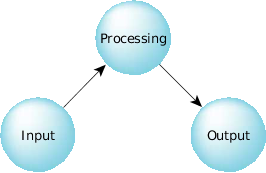Let's first understand the situation from a multiple process, one-thread-per-process outlook. In this case, we'd have three processes, literally an input process, a "processing" process, and an output process:
 Figure 1. System 1: Multiple operations, multiple processes.
Figure 1. System 1: Multiple operations, multiple processes.This is the most highly abstracted form, and also the most "loosely coupled." The "input" process has no real "binding" with either of the "processing" or "output" processes—it's simply responsible for gathering input and somehow giving it to the next stage (the "processing" stage). We could say the same thing of the "processing" and "output" processes—they too have no real binding with each other. We are also assuming in this example that the communication path (i.e., the input-to-processing and the processing-to-output data flow) is accomplished over some connectioned protocol (e.g., pipes, POSIX message queues, native QNX Neutrino message passing—whatever).